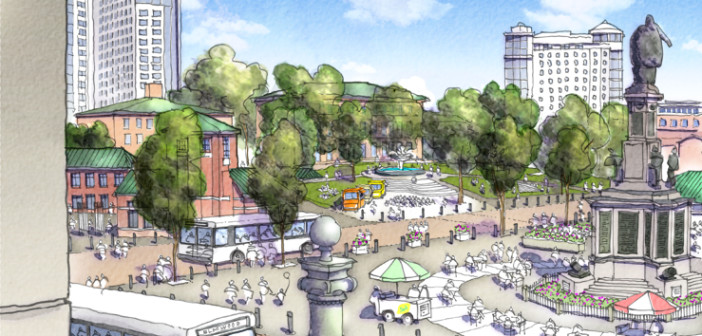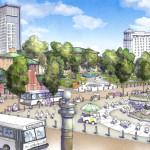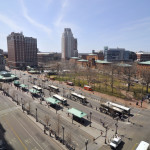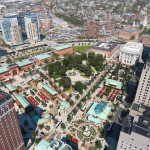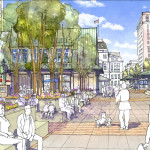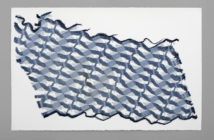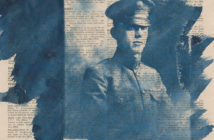One of the many joys in New England living is the palpable sense of history in all of the region’s best urban spaces. The inconveniences of slender alleyways and tightly packed neighborhoods are forgiven because these features, seemingly anachronistic to generations of suburbanites, are what make cities lively and interesting. Punctuating the signature density of urban development are the great parks, the public parlors of cities, which have for generations been where neighbors come together to play, to talk, and even to protest. Truly great urban parks give relief from the sometimes-cramped urban quarters, providing room to breath and room to gather. Today Providence, Rhode Island is reconsidering the role of its urban center and planning a reworking of the space that will restore its meaning and magnetism.
A new scheme is being imagined for Kennedy Plaza, the central square of the Ocean State’s capital city. Currently, a complex array of bus traffic lanes and copper roofed shelters for bus riders occupy the most prominent open space in the downtown area. The planned renovation of the Plaza is being spearheaded by Union Studio architects of Providence, who can walk to the Plaza from their office on nearby Union Street. Union Studio is a community-focused firm dedicated to the ideals of New Urbanism, namely, making neighborhoods livable by focusing on mixed-use construction, walkability, and usable public space. This philosophy is readily understood in their plan for the future of Kennedy Plaza, which is focused on the needs of humans over those of buses.
The plan calls for the restoration of a cohesive park on the site of the current bus terminal bookended by the Second Empire City Hall and the Beaux Art Federal Courthouse. Bus shelters will be relocated to the perimeter of the Plaza and the interior will be reclaimed as community gathering space. The plan also calls for the renovation of the adjacent Burnside Park and Bank of America Skating Center in order to tie the three spaces together and improve their overall infrastructure, making a lively and attractive urban park and event venue.
The design turns several lanes reserved for buses into a unified space, adds a fountain in front of the historic Federal Courthouse building and brings new prominence to civic interaction. Some of the fixes are simple. The small Burnside Park at the north of the site is underused currently, in part because it is fenced and has few proper entrances. The barriers to the public will be removed and the pathways and dramatic central fountain in the space will be thoroughly renovated, encouraging passersby on the surrounding sidewalks to enter and enjoy.
The reconfiguration project at Kennedy Plaza is actually a restoration, and a fantastic one at that. The Union Studio proposal reestablishes the central role of the area as a public gathering space and undoes drastic changes made in the past, which turned the bulk of the Plaza into an unsightly open-air bus depot. The bold plan to bring smart urbanism back to the city center is just what the City of Providence needs to do to restore the historic city center to its rightful use: leisure.
The pursuit of relaxation is, after all, one of the central reasons that all parks exist. Urban green spaces, from the Boston Common, to Kennedy Plaza, to Central Park provide a much-needed escape for city residents. They make room for adults to exercise and children to play. They are spaces for performance and creativity, imagination and discovery. They enable people from varying neighborhoods and walks of life to meet and to see in one another the engaging diversity that makes cities such exciting places to live and work. For all of these reasons and more, parks are essential furnishings in the life of any city and particularly those of New England where the contemporary American park, in many ways, was born.
It is important to remember that the modern notion of the public park can be traced back to early New Englanders. In towns and cities across the region, the old common grazing grounds that were once integral to the communal life of Puritan settlers have grown up and evolved, and have become, for generations, valued places of public interaction and urban vitality. With continued creative thinking on the part of cities like Providence and architects like those at Union Studio, these parks can maintain that vitality and can act as important drivers for economic prosperity, personal wellness, and cultural enrichment for generations more to come.
- Future Kennedy Plaza from Providence City Hall, Credit: Union Studio Architecture & Community Design
- Kennedy Plaza Destinations Map, Credit:Union Studio Architecture & Community Design
- Kennedy Plaza Before and After, Credit: Union Studio Architecture & Community Design
- Existing Kennedy Plaza 2013, Credit: Union Studio Architecture & Community Design
- Existing Kennedy Plaza 2013, Credit: Union Studio Architecture & Community Design
- Rendering of the Future Kennedy Plaza, Credit: Design:Union Studio, Illustration: Tim Nelson
- Rendering of the Future Kennedy Plaza 2, Credit: Design:Union Studio Illustration: Tim Nelson
- Street View of Future Kennedy Plaza, Credit: Union Studio Architecture & Community Design
- Future Kennedy Plaza Site Plan, Credit: Union Studio Architecture & Community Design

